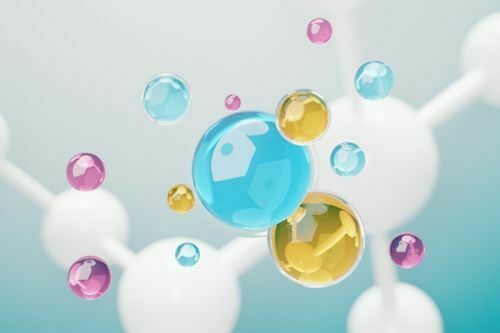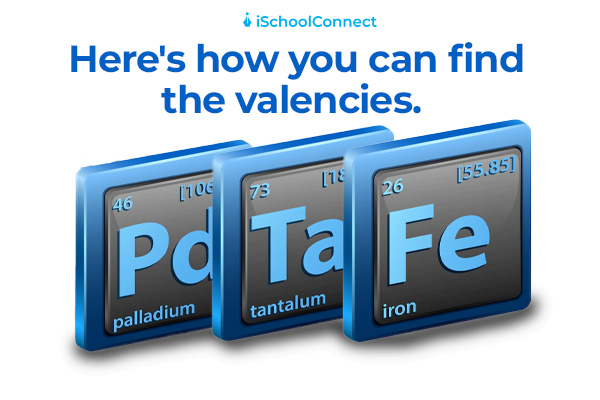Table of Contents
Valency measures an atom’s potential to bond with other atoms. The greater the number of valent electrons, the more reactive the atom or molecule. The valency of an element is proportional to the number of electrons present in the outer shell of the element’s atom. As a result, elements in the same periodic table group have the same valency. Let’s know more about how to find valency.
What is valency?
The valency of an element is the number of valence electrons in that element that participate in chemical reactions. The number of hydrogen atoms that an atom can combine with determines its combining capacity (affinity). For example, chlorine has a valence of 1 in hydrogen chloride; oxygen has a valence of 2 in water; nitrogen has a valence of 3 in ammonia, and carbon has a valence of 4 in methane.
Since chlorine has 1 valence, it can substitute it for hydrogen. Similarly, phosphorus has a valence of 5 in phosphorus pentachloride, – PCl5. Valence diagrams represent the elements’ connectivity in a compound, with lines drawn between two elements to indicate bonds.
How many electrons are in each orbital?
Electrons will take the most stable position first. The inner orbital (K) can accommodate up to two electrons. The following orbital (L) can hold up to 8 electrons. The next orbital (M) can also hold up to 8 electrons.
Within the K, L, M, and N orbitals, there are s, p, d, and f sub-orbitals.
Eight electrons in the L orbital provide stability due to the orbital being full. The L orbital is complete because there are two in the s sub-orbital and two in each of the three p sub-orbitals. It also applies to the M orbital. This is known as the octet rule.
How to find valency? (insert valency of carbon image)
First, find the atomic number using the periodic table. Let’s use carbon as our example. The atomic number is 6, which means there are 6 protons and 6 electrons. Because the inner electron orbital has two electrons, the following orbital has 4 (6 – 2 = 4).
The outer orbital can form four single bonds with four electrons moving in various directions around the nucleus. You can say that carbon has a valency of four.
What are the types of valency?

There are two types of valencies, electrovalency, and covalency. Let’s have a look at them.
Electrovalency
The electrovalency of an element is the number of electrons lost or gained by one atom to obtain the nearest inert gas electron configuration.
Example
- Magnesium loses two electrons to achieve the inert gas electron configuration, so its valency is 2 (or +2).
- Oxygen, for example, requires two electrons to achieve the nearest inert gas electron arrangement, so its electrovalency is 2 (or – 2).
Covalency
Covalency is the number of electrons shared by one atom of an element to obtain the nearest inert gas electron configuration.
Example
- Hydrogen Covalency- Since 1 atom of hydrogen shares 1 electron to achieve the nearest inert gas electron configuration, the hydrogen covalency is 1.
- Nitrogen covalency- Since 1 atom of nitrogen shares 3 electrons to achieve the nearest inert gas electronic configuration, its covalency is 3.
Calculation of valency of metals

Metal is an element with one, two, or three electrons in its valence shell (except hydrogen and helium, which are non-metals). Metals lose their valence electrons in chemical reactions, completing their octet. Therefore, the number of electrons in a metallic element’s valence shell is defined as its valency.
| Element | Atomic symbol | Atomic number | Electronic configuration | Electronic configuration | Electronic configuration | Number of valence electrons | Valency |
| K | L | M | |||||
| Sodium | Na | 11 | 2 | 8 | 1 | 1 | 1 |
| Magnesium | Mg | 12 | 2 | 8 | 2 | 2 | 2 |
| Aluminium | Al | 13 | 2 | 8 | 3 | 3 | 3 |
Calculation of valency of non-metals
If an element has 5 or 6 or 7 or 8 electrons in its valence shell, it is classified as a non-metal.
As a result, a non-metal requires 3, 2, 1, or 0 electrons to achieve its octet. Thus, the valency of a non-metallic element is equal to the number of electrons in its outermost shell. It is evident from the electronic structure of some non-metals.
| Non-metallic element | Atomic symbol | Atomic number | Electronic configuration | Electronic configuration | Number of valence electrons (x) | Valency(8-x) |
| K | L | |||||
| Fluorine | F | 9 | 2 | 7 | 7 | 8-7=1 |
| Oxygen | O | 8 | 2 | 6 | 6 | 8-6=2 |
| Nitrogen | N | 7 | 2 | 5 | 5 | 8-5=3 |
| Carbon | C | 6 | 2 | 4 | 4 | 8-4=4 |
| Neon | Ne | 10 | 2 | 8 | 8 | 8-8=0 |
Valency of the first 20 elements is as follows
| Element | Valency |
| Hydrogen | 1 |
| Helium | 0 |
| Lithium | 1 |
| Beryllium | 2 |
| Boron | 3 |
| Carbon | 4 |
| Nitrogen | 3 |
| Oxygen | 2 |
| Fluorine | 1 |
| Neon | 0 |
| Sodium | 1 |
| Magnesium | 2 |
| Aluminium | 3 |
| Silicon | 4 |
| Phosphorous | 3 |
| Sulphur | 2 |
| Chlorine | 1 |
| Argon | 0 |
| Potassium | 1 |
| Calcium | 2 |
Key takeaways
- The valency of an element is the number of valence electrons in that element that participate in chemical reactions. There are two types of valencies, electrovalency, and covalency.
- If an element contains 5 or 6 or 7 or 8 electrons in its valence shell, it is classified as a non-metal.
- The octet rule refers to atoms’ preference for having eight electrons in their valence shell. Atoms with fewer than eight electrons are more likely to react and form more stable compounds.
We hope this blog was informative and enjoyable. If so, please share your views in the comments below. Click here to contact us for more information on how to find valency. We would be delighted to assist you with your queries.
Liked this blog? Read more: Wonders of science and its affects on our life!
FAQs
Q1. What is the valency of SO4?
Answer- Sulphate gained 2 electrons to complete its octet, indicating a valency of 2. As a result, the valency of SO4 is 2.
Q2. Who discovered the term valency?
Answer- Gilbert N. Lewis defined valence and chemical bonding in 1916 by describing the tendency of (main-group) atoms to form a stable octet of 8 valence-shell electrons.
Q3. Who proposed hybridization?
Answer- L. Pauling put forth the hypothesis of hybridization, or the mixing of atomic orbitals, in 1931 to explain the tetrahedral environment of compounds of the methane type.






